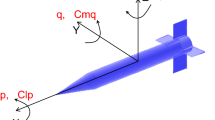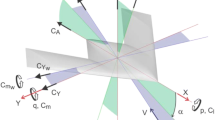Abstract
The purpose of this paper is to develop a six degree-of-freedom flight simulation while considering the flexibility of an aircraft with high aspect ratio wings using by new quasi-steady temporal coupling scheme named ‘snapshot method’. The simulation was based on the quasi-steady temporal coupling scheme for the flow field, elastic structure, and rigid body motion problem. A full three-dimensional finite-element model of unmanned aerial vehicles was used. The object aircraft has main wings with an aspect ratio over 20 and a flight for long endurance in high altitude. To consider the flexibility of these aircraft, the present snapshot method was developed that combines ‘aerodynamic—structural dynamics—flight dynamics’ to analyze dynamic response. By applying this method, MATLAB/SIMULINK, which analyzes the rigid body motion, and MSC FlightLoads, which is responsible for aeroelastic trim analysis, was tightly linked into the present simulation framework. Using the present simulation, aircraft response under various maneuver conditions was simulated. First, the trim analysis for the level cruise was performed. Trim parameters, stability derivative coefficients, and the moment of inertia were also determined. Based on these results, the flight dynamics of the aircraft was simulated according to the operation of the rudder and the aileron control surface. The effect of the rigid and flexible body assumptions was also confirmed. In addition, these results were compared with other existing simulation results based on the multibody dynamics under the same conditions. To predict the response of the aircraft under the gust, the simulation was performed by applying the two-dimensional 1-cosine discrete gust profile. The important aspects, such as numerical prediction methods during stages of the highly flexible aircraft design process for a countermeasure to various challenging problems, were shown.















Similar content being viewed by others
Abbreviations
- \( S_{kj} \) :
-
Integration matrix
- \( A_{jj} \) :
-
Aerodynamic influence coefficient matrix
- \( D_{jk} \) :
-
Substantial differentiation matrix
- \( Q_{kk} \) :
-
Aerodynamic stiffness matrix
- \( G_{kg} \) :
-
Interpolation matrix
- \( u_{g} \) :
-
Components of structural grid point displacements
- \( u_{k} \) :
-
Components of aerodynamic grid points
- \( F_{k} \) :
-
Aerodynamic forces
- \( F_{g} \) :
-
Structurally equivalent forces
- \( K_{aa} \) :
-
Structural stiffness matrix
- \( M_{aa} \) :
-
Structural mass matrix
- \( P_{a} \) :
-
Vector of applied loads
- \( u_{x} \) :
-
Set of trim parameters
- \( {\text{T}}_{Rx} \) :
-
Boolean matrix
- \( T_{rR} \) :
-
Transformer matrix
- \( u_{a}^{e} \) :
-
Elastic deformation matrix
- UAV:
-
Unmanned aerial vehicles
- FEM:
-
Finite-element method
- DLM:
-
Doublet lattice method
References
Drela M (1990) Method for simultaneous wing aerodynamic and structural load prediction. J Aircr 27(8):692–699
Brown E (2003) Integrated strain actuation in aircraft with highly flexible composite wings. Ph.D. Dissertation, Massachusetts Institute of Technology
Shearer C (2006) Coupled nonlinear flight dynamics, aeroelasticity, and control of very flexible aircraft. Ph.D. Dissertation, University of Michigan
Su W (2008) Coupled nonlinear aeroelasticity and flight dynamics of fully flexible aircraft. Ph.D. Dissertation, University of Michigan
Waszak MR, Schmidt DK (1988) Flight dynamics of aeroelastic vehicles. J Aircr 25(6):563–571
Farhat C, Pierson K, Degand C (2001) Multidisciplinary simulation of the maneuvering of an aircraft. Eng Comput 17:16–27
Spieck M, Krueger W, Arnold J (2005) Multibody simulation of the free-flying elastic aircraft. In: Proceedings of 46th AIAA/ASME/ASCE/AHS/ASC structures, structural dynamics and materials conference. American Institute of Aeronautics and Astronautics, Austin, Texas
Kim S, Chang S, Jang S, Cho M (2016) Flexible aircraft flight dynamic analysis with discrete gust. In: 2016 KSAS fall conference. Jeju
Schmidt DK, Raney DL (2001) Modeling and simulation of flexible flight vehicles. J Guid Control Dyn 24(3):539–546
Wellmer G (2014) A modular method for the direct coupled aeroelastic simulation of free-flying aircraft. Ph.D. Dissertation, RWTH Aachen University
Rodden W, Love J (1985) Equations of motion of a quasisteady flight vehicle utilizing restrained static aeroelastic characteristics. J Aircr 22(9):802–809
Blakelock JH (1991) Automatic control of aircraft and missiles, 2nd edn. A Wiley-Interscience Publication, New York
Bekey GA, Karplus WJ (1968) Hybrid computation. Wiley, New York
Rodden W, Johnson E (1994) MSC/NASTRAN aeroelastic analysis user’s guide, version 68. MacNeal-Schwendler Corp, Los Angeles
Nelson RC (1998) Flight stability and automatic control, 2nd edn. WCB/McGraw-Hill, New York
Sikes G, Neill DJ (2001) MSC/FlightLoads and dynamics. MSC Software, Newport Beach
Egle D, Ausman J (2001) Integration of MSC flightloads and dynamics at lockhead martin aeronautics company. MSC Software, Newport Beach
Rodden W, Revell J (1963) The status of unsteady aerodynamic influence coefficients. AIAA J 1(3):724–725
Acknowledgements
This research was supported by Basic Science Research Program through the National Research Foundation of Korea (NRF) funded by the Ministry of Science, ICT and future Planning (2017R1A2B4004105).
Author information
Authors and Affiliations
Corresponding author
Rights and permissions
About this article
Cite this article
Been, Y., Kang, Y., Kim, S. et al. Development of the Snapshot Method for Six Degree-of-Freedom Flight Dynamics Simulation of a High Aspect Ratio Wing Aircraft. Int. J. Aeronaut. Space Sci. 19, 904–919 (2018). https://doi.org/10.1007/s42405-018-0097-0
Received:
Revised:
Accepted:
Published:
Issue Date:
DOI: https://doi.org/10.1007/s42405-018-0097-0




